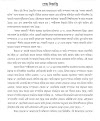Abhijit Chaliha
abhijitchaliha1409@gmail.com
As the Treaty of Yandabo approaches its bicentennial in February 2026, it invites a deeper reflection not just on colonial geopolitics, but also on its far-reaching cultural and linguistic consequences. Signed on February 24, 1826, the treaty brought an end to the First Anglo-Burmese War and formally transferred control of Assam, among other territories, from the Burmese Empire to the British East India Company. While this moment is often remembered in terms of military and territorial shifts, its impact on the Assamese language, identity, and Assam's historic connection with Burma (present-day Myanmar) is profound and enduring.
The First Anglo-Burmese War was one of the most devastating episodes in early 19th-century South and Southeast Asian history. For Assam, it came on the heels of a brutal Burmese occupation that began in 1817. Known locally as the “Manar Din,” or “the Burmese days,” this period was marked by widespread violence, displacement, and administrative collapse. The fall of the Ahom kingdom and the occupation of Assam by the Konbaung dynasty devastated the region. The eventual defeat of Burma in the war and the signing of the Treaty of Yandabo was, for many in Assam, a form of liberation. However, it also marked the beginning of another era of domination—this time by the British.
The British takeover of Assam following the treaty introduced a new colonial administrative framework that would reshape the region’s cultural trajectory. One of the most significant outcomes was the marginalization of the Assamese language. In 1836, a mere decade after the treaty was signed, the British administration replaced Assamese with Bengali as the language of education and official communication. This decision, made ostensibly for administrative convenience, had far-reaching implications. It sidelined Assamese from public life, schools, and government, leading to a cultural and linguistic alienation that would last for several decades.
This imposition of Bengali sparked a linguistic crisis in Assam. Assamese, despite its rich literary tradition and historical depth, was dismissed as unsuitable for administration. The displacement of the mother tongue from educational and bureaucratic systems left a generation of Assamese speakers without formal grounding in their own language. This cultural suppression led to a strong intellectual movement for the revival and recognition of Assamese. Writers and reformers like Anandaram Dhekial Phukan, Hemchandra Barua, and Lakshminath Bezbaroa led a renaissance that laid the foundation for modern Assamese literature and linguistic pride. Ironically, it was the aftermath of the Treaty of Yandabo and the linguistic injustice that followed which triggered this awakening.
Another overlooked aspect of the treaty is the rupture it created between Assam and Burma, two regions that once shared more than just borders. The Ahom dynasty, which ruled Assam for nearly six centuries, had ancestral and cultural connections with regions in present-day Myanmar. Ethnic groups such as the Tai-Ahom, Singpho, and Khamti people still reflect this shared heritage through their customs, language, and traditions. Prior to colonial boundaries, the relationship between Assam and Burma was shaped by trade, diplomacy, conflict, and kinship. The Treaty of Yandabo introduced a strict geopolitical boundary that replaced centuries of fluid cultural exchanges with rigid colonial frontiers.
The creation of hard borders in 1826 effectively severed Assam’s historic ties with Burma. It transformed Assam from an independent cultural and political entity into a peripheral frontier of British India. The Northeast region became increasingly isolated from its eastern neighbors, including Myanmar, and was instead integrated into the administrative machinery of British Bengal. This dislocation has had long-term consequences for regional connectivity, both economically and culturally. Even today, cross-border engagement between Assam and Myanmar remains minimal, hampered by geopolitical complexities and security concerns.
As the 200th anniversary of the Treaty of Yandabo draws near, it provides an opportunity to revisit this pivotal chapter in Assam’s history with renewed attention. Commemoration of this bicentenary should go beyond formalities and seek to uncover the deeper, often overlooked layers of the treaty’s legacy. It is not only a story of colonial conquest but also a story of linguistic resistance, cultural survival, and historical disconnection. This moment calls for academic inquiry, public discourse, and cultural initiatives that reflect on the complex heritage left in the treaty’s wake.
The Treaty of Yandabo marked the beginning of a new political order in Assam, but it also marked the beginning of a struggle for linguistic and cultural self-assertion. Assamese language, once pushed to the margins, rose again through the determination of its people. That resilience is a defining feature of Assam’s identity today. Understanding this journey requires acknowledging the role of treaties, colonial decisions, and historical turning points that shaped the region’s destiny.
As we approach the bicentenary, it is essential to remember that the Treaty of Yandabo was more than a document that ended a war. It was a dividing line between empires, but also between histories—one that disconnected Assam from its eastern heritage while connecting it to a colonial system that would redefine its future. The 200th anniversary is a reminder that history’s turning points do not just redraw maps; they rewrite languages, identities, and lives.























0 Comments